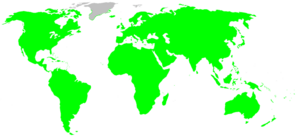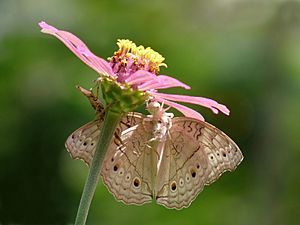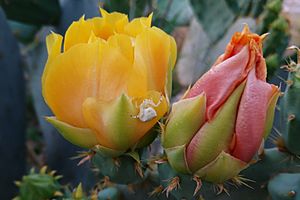Thomisidae facts for kids
Quick facts for kids Thomisidae |
|
|---|---|
| Scientific classification |
|
| Kingdom: | Animalia |
| Phylum: | Arthropoda |
| Subphylum: | Chelicerata |
| Class: | Arachnida |
| Order: | Araneae |
| Infraorder: | Araneomorphae |
| Family: | Thomisidae Sundevall, 1833 |
| Diversity | |
| 171 genera, 2,167 species | |
 |
|
Crab spiders are a family of spiders called Thomisidae. There are about 170 different types (genera) and over 2,100 species of these spiders. People often call many different spiders "crab spiders." But this name usually refers to the Thomisidae family. Many of these spiders are also known as flower spiders or flower crab spiders.
What are Crab Spiders Like?
These spiders do not build webs to catch their food. Instead, they are ambush predators. This means they hide and wait for their prey. Their two front legs are usually longer and stronger than their other legs. The two back legs are smaller and have strong spines.
Crab spiders can be dull colors like brown or grey. But they can also be very bright. Some are green, pink, white, or yellow. They get their name because their bodies look like crabs. They also often move sideways or backwards, just like crabs! It's usually easy to tell them apart from other spiders.
Why are they Called Crab Spiders?
Spiders in this family are called "crab spiders" for a few reasons. First, they look a bit like crabs. Second, they hold their two front pairs of legs in a way that looks like a crab's claws. Third, they can scuttle sideways or backwards.
The Thomisidae family is the main group known as "crab spiders." But other spiders also use this name. For example, some large spiders are called "giant crab spiders." Others are called "wall crab spiders" or "six-eyed crab spiders." Even some orb-weaver spiders are sometimes called "crab spiders."
How Crab Spiders Behave
Crab spiders do not build sticky webs to catch insects. However, they do make silk. They use silk for safety lines if they fall. They also use it for laying eggs. Some crab spiders are hunters that wander around. But most of them are ambush predators.
Many species sit on or near flowers or fruit. They wait there to grab insects that come to visit. Some types, like the Misumena vatia, can even change their color! They do this over a few days to match the flower they are sitting on. This helps them hide from prey.
Other species hide among leaves or on tree bark. They wait there for their next meal. Some even sit out in the open. They are very good at looking like bird droppings! This helps them stay hidden from both prey and predators.
Some crab spiders have flat bodies. They hunt in cracks in tree trunks or under loose bark. They might also hide there during the day and hunt at night. Spiders from the Xysticus group hunt in the leaves on the ground. All crab spiders use their strong front legs to grab prey. Then they bite it with venom to paralyze it.
A group of spiders called Aphantochilidae used to be a separate family. But now they are part of the Thomisidae. These Aphantochilus spiders look like Cephalotes ants. They even hunt these ants!
Most spiders in the Thomisidae family are not harmful to humans. However, there is a different group of spiders called Sicarius. These are sometimes called "crab spiders" too. But they are related to dangerous recluse spiders. They have very strong venom, but they rarely bite humans.
Sexual Dimorphism: Differences Between Males and Females
Crab spiders show different kinds of sexual dimorphism. This means males and females of the same species look different. Sometimes, their colors are different. But the biggest difference is usually their size.
In some species, the size difference is small. Female Misumena vatia spiders are about twice as big as the males. In other species, the difference is huge! Female Thomisus onustus spiders can be more than 60 times heavier than the males.
Scientists have different ideas about why these size differences happen. One idea is about how many eggs females can lay. Larger females can produce more eggs. They can also have healthier baby spiders. Males do not lay eggs, so being bigger doesn't help them in the same way.
Another idea is that male spiders are smaller on purpose. Being smaller helps males travel more easily. This means they can find more mates. Females usually stay in one place more. Their larger size helps them catch bigger prey, like butterflies and bees. These extra nutrients are important for making eggs.
Some scientists also think that the size difference might have happened by chance. They believe there might not be a special reason for females to be bigger or males to be smaller.
Images for kids
-
An Amyciaea spider that looks like an ant.
See also
 In Spanish: Arañas cangrejo para niños
In Spanish: Arañas cangrejo para niños
- Philodromidae, another family sometimes called crab spiders









